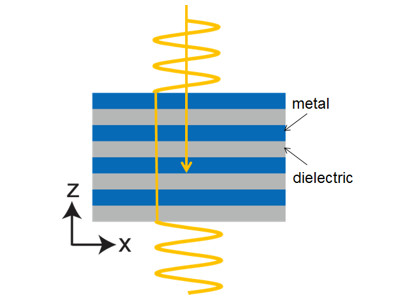 Press Release 2015
Press Release 2015
Peculiar Property of an Optical Metamaterial Having a Zero-Refractive Index has been Theoretically Demonstrated
The Material May be Applicable to the Development of New Optical Elements and Photonic Integrated Circuits
A team of a NIMS researcher and a Purdue Professor in the United States has theoretically demonstrated that a metamaterial made of periodic metal-dielectric multilayers has unique properties due to non-local topological transition at the critical state and induce zero-refractive index.
A research led by Satoshi Ishii, a scientist at the International Center for Materials Nanoarchitectonics (MANA), NIMS, and Professor Evgenii Narimanov at Purdue University in the United States, has theoretically shown for the first time that a metamaterial made of periodic multilayers of metal and dielectric has unique properties such as having zero-refractive index for light at a certain wavelength (critical state). A material having zero refractive index allows light to travel at a constant phase, thus making light to be guided even if the optical waveguides are severely bent or distorted. Thus, by further exploring these results in experiments, it may be feasible to develop new optical elements and photonic integrated circuits.
In recent years, active research has been carried out worldwide to develop new optical elements, which do not occur naturally, using artificial structures called metamaterials. Among them, metal–dielectric periodic multilayer structures, called hyperbolic metamaterials (HMMs), are particularly attracting attentions due to their simple structure yet having unique applications such as super-resolution lenses and enhanced spontaneous emission from single-photon sources.
Depending on the direction from which light enters an HMM—either from the upper surface or from a side—it had been generally believed that the HMM has only two types of responses to the incoming light: it behaves like a metal (reflects light) or behaves like a dielectric (causes light to refract in the negative direction), in relation to the frequency of light. The research team has succeeded analyzing the transition between the two types induced by the non-local topological transition. In addition, they also found that in response to incoming light at a certain wavelength (critical state), an HMM exhibits peculiar optical properties such that its effective refractive index becomes zero and it causes the light to undergo conical refraction.
In future studies, the team is planning to apply HMMs to the development of optical elements and photonic integrated circuits by conducting in-depth analysis of the critical states caused by t non-local topological transitions.
This study was in part carried out as the NIMS 3rd Mid-Term Program Project on System Nanotechnology. This research was published in the online journal Scientific Reports on December 16, 2015.

Schematic of light through a hyperbolic metamaterial (HMM) in a critical state where the effective refractive index is zero. Blue and gray stripes represent metal and dielectric layers, respectively.

